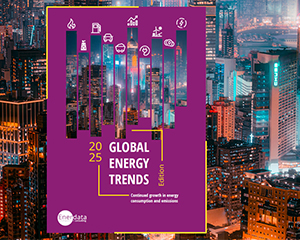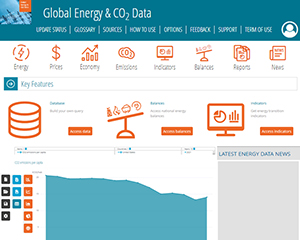용어해설
LNG 무역수지
The trade balance is the difference between imports and exports. The balance of a net exporter appears as a negative value (-). The balance of geographic and geopolitical zones is simply the sum of the trade balance of all the countries. LNG (liquefied natural gas) is natural gas, mainly made of methane (CH4), that is cooled down at -160°C to become liquid and non-corrosive, and to reduce its volume by around 600 times. LNG can thus be stored in tanks and can be easily transported by ship instead of gas pipelines, increasing the flexibility of global gas trade.
석유제품 국내 소비
Consumption (or domestic supply) is the balance of production, external trade and stock changes. Marine bunkers are excluded for countries. They are included at the world level. Consumption is mainly divided between power plants, industry, transport and the residential and tertiary sectors, one part is used or lost in the energy transformation. Petroleum products are all liquid hydrocarbons, obtained by the refining of crude oil and NGL and by treatment of natural gas; in particular, LPG production (Liquid Petroleum Gas) includes LPG from natural gas separation plants. The alcohol used as motor fuel in Brazil as well as fuels derived from coal in South Africa are not included in oil products.
석유제품 무역수지
The trade balance is the difference between imports and exports. The balance of a net exporter appears as a negative value (-). The balance of geographic and geopolitical zones is simply the sum of the trade balance of all the countries. Petroleum products are all liquid hydrocarbons, obtained by the refining of crude oil and NGL and by treatment of natural gas; in particular, LPG production (Liquid Petroleum Gas) includes LPG from natural gas separation plants. The alcohol used as motor fuel in Brazil as well as fuels derived from coal in South Africa are not included in oil products.
석탄 및 갈탄 국내 소비
Consumption (or domestic supply) is the balance of production, external trade and stock changes. Coal and lignite represent all mineral solid fuels. Their calorific values vary very much from hard coal to lignite (national average coefficients are used).
석탄 및 갈탄 무역수지
The trade balance is the difference between imports and exports. The balance of a net exporter appears as a negative value (-). The balance of geographic and geopolitical zones is simply the sum of the trade balance of all the countries. Coal and lignite represent all mineral solid fuels. Their calorific values vary very much from hard coal to lignite (national average coefficients are used).
석탄 및 갈탄 생산
Coal production corresponds to gross production. Coal and lignite represent all mineral solid fuels. Their calorific values vary very much from hard coal to lignite (national average coefficients are used).
연료연소로부터 이산화탄소 배출
CO2 emissions cover only the emissions from fossil fuels combustion (coal, oil and gas) by sector. They are calculated according to the UNFCCC methodology (in line with the 2006 IPCC Guidelines for National Greenhouse Gas Inventories).
원유 무역수지
The trade balance is the difference between imports and exports. The balance of a net exporter appears as a negative value (-). The balance of geographic and geopolitical zones is simply the sum of the trade balance of all the countries. Crude oil includes all liquid hydrocarbons to be refined: crude oil, liquids from natural gas (Natural Gas Liquid or NGL) and semi-refined products.
원유생산
Crude oil production corresponds to gross production. Crude oil includes all liquid hydrocarbons to be refined: crude oil, liquids from natural gas (Natural Gas Liquid or NGL) and semi-refined products.
일정한 구매력 평가지수에서 GDP의 에너지 집약도
The energy intensity is calculated by dividing the total energy consumption of a country by its Gross Domestic Product (GDP). It measures the total amount of energy necessary to generate one unit of GDP. Total energy consumption includes coal, gas, oil, electricity, heat and biomass. GDP is expressed at constant exchange rate and purchasing power parity to remove the impact of inflation and reflect differences in general price levels and relate energy consumption to the real level of economic activity. Using purchasing power parity rates for GDP instead of exchange rates increases the value of GDP in regions with a low cost of living, and therefore decreases their energy intensities.
일정한 구매력평가 지수에서의 이산화탄소 집약도
CO2 intensity is the ratio of CO2 emissions from fuel combustion over Gross Domestic Product (GDP). It measures the CO2 emitted to generate one unit of GDP. GDP is expressed at constant exchange rate and purchasing power parity to remove the impact of inflation, reflect differences in general price levels and relate energy consumption to the real level of economic activity. Using purchasing power parity rates for GDP instead of exchange rates increases the value of GDP in regions with a low cost of living, and therefore decreases their CO2 intensities. CO2 emissions cover only the emissions for fossil fuels combustion (coal, oil and gas).
전기 국내 소비
Consumption (or domestic supply) is the balance of production and external trade. It is mainly divided between power plants, industry, transport and the residential and tertiary sectors, one part is used or lost in the energy transformation. Electricity corresponds to the electricity produced and transported for commercial purposes, used by ad-hoc devices.
전기 무역수지
The trade balance is the difference between imports and exports. The balance of a net exporter appears as a negative value (-). The balance of geographic and geopolitical zones is simply the sum of the trade balance of all the countries. Electricity corresponds to the electricity produced and transported for commercial purposes, used by ad-hoc devices.
전기 생산
Electricity production corresponds to gross production. It includes the public production (production of private and public electricity utilities) and the autoproducers, by any type of power plants (including cogeneration). Electricity corresponds to the electricity produced and transported for commercial purposes, used by ad-hoc devices.
전기생산에서 신재생 점유율(수력 포함)
Ratio between the electricity production from renewable energies (hydro, wind, geothermal and solar) and the total electricity production. Electricity corresponds to the electricity produced and transported for commercial purposes, used by ad-hoc devices.
정제석유제품 생산
Petroleum products are all liquid hydrocarbons, obtained by the refining of crude oil and NGL and by treatment of natural gas; in particular, LPG production (Liquid Petroleum Gas) includes LPG from natural gas separation plants. The alcohol used as motor fuel in Brazil as well as fuels derived from coal in South Africa are not included in oil products.
천연가스 국내 소비
Consumption (or domestic supply) is the balance of production, external trade and stock changes. Natural gas is mainly made of methane (CH4). It is marketed after separation of the liquid fractions. The calorific power of natural gas varies according to its methane concentration. The standard coefficient used by Enerdata is: 0.82 toe/m3, for important countries national coefficients are used.
천연가스 무역수지
The trade balance is the difference between imports and exports. The balance of a net exporter appears as a negative value (-). The balance of geographic and geopolitical zones is simply the sum of the trade balance of all the countries. Natural gas is mainly made of methane (CH4). It is marketed after separation of the liquid fractions. The calorific power of natural gas varies according to its methane concentration. The standard coefficient used by Enerdata is: 0.82 toe/m3, for important countries national coefficients are used.
천연가스 생산
Natural gas production corresponds to the marketed production (i.e. excluding quantities flared or reinjected). Natural gas is mainly made of methane (CH4). It is marketed after separation of the liquid fractions. The calorific power of natural gas varies according to its methane concentration. The standard coefficient used by Enerdata is: 0.82 toe/m3, for important countries national coefficients are used.
총 1차 생산
The primary production evaluates the quantity of natural energy resources ("primary energy sources") extracted or produced. It includes coal, gas, oil, electricity, heat and biomass production. For natural gas, the quantities flared or reinjected are excluded. Production of hydro, geothermal, nuclear and wind electricity is considered as primary production.
총 무역수지
The trade balance is the difference between imports and exports. The balance of a net exporter appears as a negative value (-). The balance of geographic and geopolitical zones is simply the sum of the trade balance of all the countries. Total energy includes coal, gas, oil, electricity, heat and biomass.
총 에너지 소비
For each energy product, it is the sum of primary production, external trade, marine bunkers (fuel used by boats and aircraft for international transport) and stock variations. For the world, marine bunkers are included. This induces a gap with the sum of regions. Total energy includes coal, gas, oil, electricity, heat and biomass.
총 최종 에너지 소비량 중 전기의 비율
Share of electricity in total final energy consumption.
평균 이산화탄소 배출 계수
The average CO2 emission factor (carbon factor) is calculated by the ratio between CO2 emissions to primary energy consumption.
풍력 및 태양광/열 발전량 비중
Electricity produced from wind and solar energy divided by the total electricity production.
2025년 글로벌 에너지 동향은 핵심 에너지 데이터에 대한 인사이트를 제공합니다
우리는 이러한 결과를 장기적인 기후 목표와 관련하여 분석했습니다.
- 2050년 목표를 달성하기 위해 노력을 더 기울여야 할 지역은 어디입니까?
- 유럽이 파리협정 목표 달성에 어려움을 겪는 근본적인 원인은 무엇입니까?
- 기후 변화 완화에 실질적으로 기여하고 있는 지역은 어디입니까?
에너지 공급, 수요, 가격 및 GHG 배출에 대해 가장 종합적이며 최신의 정보를 제공하는 데이터베이스에 접속하세요(186개국).
- 포괄적
- 1990년부터의 연간 에너지 및 온실가스 데이터
- 연간 최대 2000개 이상의 국가별 데이터 시리즈 및 지표
- 186개국의 모든 에너지에 대한 데이터 제공
- 30년간 축적된 에너지 잔액 및 통계 경험



